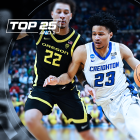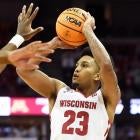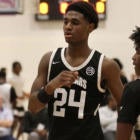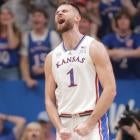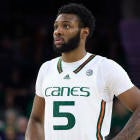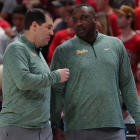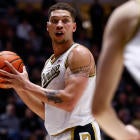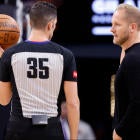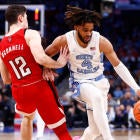
This year, over 1,000 Division I men's basketball players entered the transfer portal, making for another hectic period in which the "offseason" was very much just a second season for coaches and players alike. The former sought to keep rosters intact or rebuild them while the latter looked for new homes. It's a trend that has left coaches exhausted, and in many cases, it's nearly impossible to follow who is going, who is leaving, who is in high demand and who should be avoided.
CBS Sports' Kyle Boone ranked the top 50 transfers, and from star bigs to sneaky guards, from small schools to big and vice versa, from surprising departures to expected adieus, it's been a wild ride. Here's how the top five players will immediately impact their new squads.
1. Hunter Dickinson (Michigan to Kansas)
Dickinson isn't perfect, but it's easy to see why he's first on these rankings: He just produces and produces and produces. Over the last 25 seasons, just four Big Ten players have averaged 18 points and nine rebounds while making at least 20 3-pointers in a season.
- 2009-10 Evan Turner (AP Player of the Year, Naismith Award, Wooden Award, First-Team All-America, Big Ten Player of the Year)
- 2016-17 Caleb Swanigan (First-Team All-America, Big Ten Player of the Year, Naismith Award finalist, Wooden Award finalist)
- 2019-20 Luka Garza (First-Team All-America, Big Ten Player of the Year, Kareem Abdul-Jabbar Award, Naismith Award finalist, Wooden Award finalist)
- 2022-23 Hunter Dickinson
The awards say Turner, Swanigan and Garza put together all-time great seasons. Dickinson's top honor last season was a second-team All-Big Ten nod after to a down year for Michigan. But Kansas seems like a program immune to down years, and now Dickinson will get the chance to be a top player on a top team.
Last season, Dickinson scored 286 points on post ups alone. That was fourth nationally, and two of the players ahead of him were Zach Edey and Drew Timme. There simply aren't a lot of guys who can do this:
If you're too small, he'll stuff you in the basket. If you're too slow, he has great footwork, a bevy of post moves and is comfortable over either shoulder. Even good defense often isn't good enough.
Dickinson is also a very good and willing passer for his size. His 73 assists in 2021-22 are fifth-most by a player 7 feet or taller over the last quarter-century. He makes very good reads with skip passes galore.
This makes his fit at Kansas fascinating. Dickinson alone had 287 post ups last year. Kansas as a team had 108. Just 3.8% of the Jayhawks' possessions ended in a post up, tied for 326th in the nation. It's safe to say the offense will look very different this season, but nothing Bill Self hasn't worked with before; he's had post up-heavy teams before with David McCormack, Udoka Azubuike, Dedric Lawson and plenty more before them. Offensively, Dickinson is the best and most versatile of the bunch.
2. Max Abmas (Oral Roberts to Texas)
It doesn't require a whole lot of video or statistical analysis to tell you Max Abmas gets buckets. Over the past two seasons, only Darius McGhee and Antoine Davis scored more points. Only McGhee, Davis and Jordan Walker have made more 3-pointers.
It's not just volume, though; Abmas is an extremely efficient shooter. His 1.286 points per possession on spot ups was in the 97th percentile last year. Playing alongside Tyrese Hunter, Abmas should get plenty of good looks and his past performance suggests he'll make them at an elite clip.
Abmas is also terrific in the open floor, a huge reason why he was so appealing to Texas and Texas was so appealing to him. The Longhorns were in the 95th percentile in points per transition possession last season, and Abmas is a menace in transition; his 189 points in transition last season were fifth in all of men's Division I. He has absolutely ridiculous range but also a willingness to attack the basket.
We'll see how Abmas adjusts to the length and athleticism of major-conference play and if he can improve as a defender, but there's no doubt he brings a scoring penchant few other players possess.
3. Kel'El Ware (Oregon to Indiana)
Ware is a complete mystery. The No. 7 player in the 2022 recruiting class, Ware averaged just 6.6 points in about 15 minutes per game for an NIT-bound Oregon squad. There were some impressive spurts -- 48 points and 25 rebounds in a three-game span against UConn, Michigan State and Villanova -- and some confounding lows, including a three-game mid-February stretch in which he played just 10 total minutes and didn't score a single point.
Ware's highlights ooze ridiculous potential. He hits fadeaway jumpers off post ups, dunks alley-oops and putbacks and defends the rim with vigor. His 8.9% block rate would have been in the top 30 nationally had he played enough minutes to qualify. But the last part of that sentence is key. He didn't even play in a key late-January game against Utah, and Dana Altman pointedly said after the game, "You have to earn your playing time," while guard Jermaine Couisnard said, "He doesn't understand how hard you have to play at this level."
Will a year of experience and a fresh start at a new school help? The Hoosiers are desperate for post play after the departures of Trayce Jackson-Davis and Race Thompson, and five-star freshman Mackenzie Mgbako was arrested in late October. There should be plenty of opportunities for Ware to capitalize. We'll see if he does.
4. LJ Cryer (Baylor to Houston)
This was one of my favorite transfers of the offseason. After losing Marcus Sasser (NBA) and Tramon Mark (transfer), the Cougars needed some backcourt scoring punch alongside Jamal Shead, and Cryer absolutely brings it.
Over the last two seasons, 136 players made at least 130 3-pointers. Only one had a higher 3-point field goal percentage than Cryer's 43.4%. He's extremely efficient and a proven producer against high-level competition. Last year, three of his seven 20-point games came against ranked teams, and he had a career-high 30 in his final game with the Bears, in the NCAA Tournament against Creighton. This all came despite him playing third fiddle to Keyontae George and Adam Flagler, two extremely talented scorers in their own right.
As for his specific fit with Houston, Cryer's shooting is what immediately stands out. The Cougars were a spot up-heavy team last year, and Cryer ranked in the 89th percentile in points per spot up possession. However, Cryer is also a truly elite shooter coming off screens, a shot Houston historically has taken at very low rates. Cryer and Shead should be one of the nation's best duos, and Cryer could emerge as a true go-to scorer.
5. Tramon Mark (Houston to Arkansas)
Eric Musselman has never been shy about using the transfer portal -- he added five transfers this offseason -- and Mark is his latest headliner. Mark announced his transfer intentions as he was going through the NBA Draft process before ultimately pulling out.
The NBA's loss should be Musselman's gain. Mark stands 6-5 and is a lockdown defender. Per Synergy Sports tracking, he allowed just 26.3% shooting as the primary defender, lowest out of 495 players with at least 250 possessions as primary defender last year.
Offense has been much more of a mixed bag for the lefty, but there have been some encouraging signs. His 3-point percentage has risen every year, and while it was only at 32.8% last season, it was a very solid 36.5% in conference play. He had 26 points in the Cougars' NCAA Tournament game against Auburn, using his size and length to overwhelm the Tigers' smaller backcourt.
Even with the 3-point progress, this is Mark at his best: attacking downhill and going up and over defenders.
It's important to note, too, that Mark will be in his second year back after shoulder surgery wiped out nearly all of his 2021-22 season. If his offensive game continues to come along, he'll be another player in the long line of successful transfers to Fayetteville.













